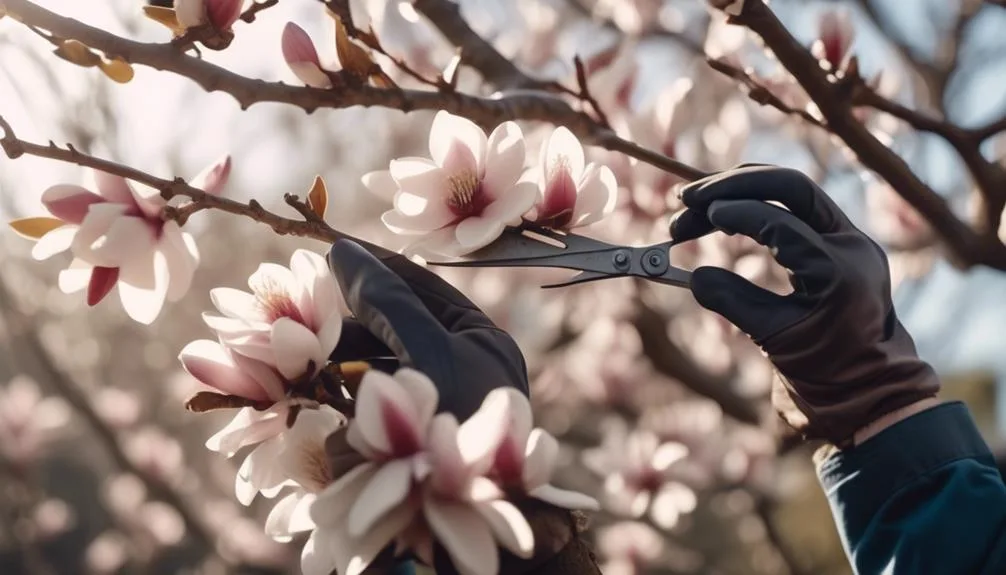As the cool fall weather sets in, the green leaves of your magnolia tree start turning into beautiful golden colors. It's important to get your magnolia ready for winter.
From putting on mulch to careful pruning, there are important steps you can take to protect your tree from the cold.
Let's look at the essential ways to prepare your magnolia trees for the upcoming winter season.
Timing for Winter Preparation
As you prepare your magnolia trees for winter, it's important to consider the timing for winter preparation to ensure their health and resilience during the colder months. When it comes to soil preparation, it's best to start in late summer or early fall. This gives the tree's roots time to benefit from any amendments and allows the soil to settle before winter.
Winter fertilization should be timed carefully as well. It's advisable to apply a slow-release fertilizer in late fall, just before the ground freezes. This helps the tree to maintain essential nutrients throughout the winter months.
Trimming and Pruning Techniques
When preparing to trim and prune your magnolia trees, it's important to remember a few key pruning tips to ensure the health and vitality of your trees. Understanding the branch structure and growth patterns of magnolia trees is crucial for selective trimming and seasonal maintenance.
Here are some essential pruning tips to keep in mind:
- Assess the branch structure: Identify any dead, damaged, or diseased branches for removal.
- Practice selective trimming: Focus on removing specific branches to promote healthy growth and maintain the tree's natural shape.
- Consider seasonal maintenance: Timing your pruning efforts can help minimize stress on the tree and encourage new growth.
- Seek professional guidance if needed: For larger or more complex pruning tasks, consulting with a professional arborist can ensure proper care for your magnolia trees.
Mulching and Protecting the Roots
To protect the roots of your magnolia trees during winter, mulching is a crucial practice that helps insulate the soil and maintain moisture levels. Apply a 2 to 4-inch layer of organic mulch, such as wood chips or shredded bark, around the base of the tree, extending out to the drip line. This will aid in root insulation, keeping the soil temperature stable and protecting the roots from freezing temperatures.
Additionally, mulch acts as a barrier, reducing moisture evaporation from the soil, which is especially important during the drier winter months. Be mindful not to mound the mulch directly against the trunk to prevent rot and pest infestation.
Proper mulching is essential for safeguarding the roots of your magnolia trees and ensuring their health during the winter season.
Winter Watering and Hydration
Consider adjusting your watering practices during winter to ensure proper hydration for your magnolia trees without overwatering. Winter watering is crucial for the overall health and survival of your magnolia trees.
Here are some essential tips to help you maintain soil moisture and root insulation during the winter months:
- Monitor soil moisture regularly to ensure it doesn't dry out completely.
- Water deeply but infrequently to promote deep root growth and prevent waterlogging.
- Consider using a soaker hose or drip irrigation to deliver water directly to the root zone.
- Apply a layer of organic mulch around the base of the tree to help retain soil moisture and provide root insulation.
Pest Control and Disease Prevention
To maintain the health of your magnolia trees during winter, implementing an effective pest control and disease prevention plan is essential. Proper care can help safeguard your trees against fungal infections and insect damage. Here are some key strategies to protect your magnolia trees:
| Pest Control | Disease Prevention |
|---|---|
| Use insect repellent | Monitor for fungal infections |
| Maintain soil health | Ensure proper nutrient management |
| Regularly inspect for pests | Prune dead or diseased branches |
| Clean up fallen leaves | Apply fungicides if necessary |
Conclusion
Incorporating these winter preparations for your magnolia trees will help ensure their health and vitality during the colder months. By timing maintenance and proper pruning, you can promote the growth and development of your magnolia trees. Mulching and root protection will provide insulation and shield the roots from freezing temperatures. Hydration is crucial, especially during dry winters, so be sure to water your magnolia trees regularly. Additionally, practicing vigilant pest management will help prevent infestations and damage to your trees. With these practices in place, you can look forward to enjoying the beauty of your magnolia trees for many winters to come.

My interest in trees started when I first saw the giant sequoias in Yosemite.
I was a teenager then, and I remember thinking, “I need to learn more about this.”
That moment stuck with me.
A few years later, I went on to study forestry at Michigan Tech.
Since graduating, I’ve worked in a mix of hands-on tree care and community education.
I’ve spent over ten years helping people understand how to plant, maintain, and protect the trees in their neighborhoods.
I don’t see trees as just part of the landscape.
They are living things that make a real difference in our daily lives.
